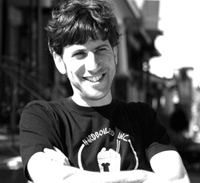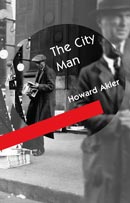TDR Interview: Howard Akler
 Howard Aklerís novel
The
City Man (Coach House Books, 2005) is a punchy mix of pulp fiction, crime
noir and prototypical Canadian literary fiction. Itís set in Toronto
in 1934, with the city mired in the Great Depression. A gang of
pickpockets are on the loose in Union Station and at centenary parade
celebrations, among them the saucy Mona Kantor. Star reporter Eli
Morenz takes on the story, digging into the pickpocket underworld to
reveal the intricacies of the trade and falling for Mona in the process.
Morenz and Kantor have to walk a fine line Ė one to keep his sources
private, the other to stay on the street and out of the grasp of the
cops who view the pickpockets as a scourge. Howard Aklerís novel
The
City Man (Coach House Books, 2005) is a punchy mix of pulp fiction, crime
noir and prototypical Canadian literary fiction. Itís set in Toronto
in 1934, with the city mired in the Great Depression. A gang of
pickpockets are on the loose in Union Station and at centenary parade
celebrations, among them the saucy Mona Kantor. Star reporter Eli
Morenz takes on the story, digging into the pickpocket underworld to
reveal the intricacies of the trade and falling for Mona in the process.
Morenz and Kantor have to walk a fine line Ė one to keep his sources
private, the other to stay on the street and out of the grasp of the
cops who view the pickpockets as a scourge.
The novel is exceptional because Akler
peppers the prose with pickpocket lingo: "We used to work the hotel
hustle, yíknow. King Eddy, Royal York. And we angle this bates one
day. A jug touch for sure, donít even have to fan the guy to know heís
fat." The vernacular takes some getting used to but once you settle
in, it innovatively adds authenticity to the tale and you bounce right
along with it.
Matthew Firth conducted this interview
electronically in October 2005.
*
The novel has great pace. Short, sharp chapters. Sparse descriptions.
Punchy, dialogue. It moves quite quickly. Why?
I wanted a breathless kind of book,
one with small meticulous details mixed in with the larger swirl of
events.
 Coach House
Books is known for publishing innovative books. Would you
call your novel innovative, if so, what makes it innovative? Coach House
Books is known for publishing innovative books. Would you
call your novel innovative, if so, what makes it innovative?
I donít know if Iím doing
anything real new here.
I have to ask about the speech used by the pickpockets, the lingo of the
street of the day. How did you research that and make it ring so true?
The pickpocket lingo comes from a
great book called Whiz Mob, by David W. Maurer. Maurer was a linguistics
professor at University of Kentucky who specialized in the argot of
various "sub-cultures", such as pickpockets, moonshiners, drug
addicts, and con men. The movie "The Sting" ripped off Maurerís
stuff and, I think, never credited him.
Your descriptions of pickpockets are similarly meticulous Ė every
small gesture and twitch is described beautifully, artfully. Whereíd
you get this knowledge and how did you make it sound so plausible?
Again, Maurerís book. After reading
it, I began trying to break down all these little actions that go on in
a crowd. Try it! Wander in the middle of a crowd and imagine lightly
running your hands over a total stranger, locating and stealing a
wallet, all in a matter of seconds. Itís an amazingly physical task,
fast and precise. Itís really a gentle art. Especially combined with
such wild slang. Pinch a poke, bang a souper, plant your prat. These
phrases all sound so sexually charged but the theft itself is a whisper.
Even though I grew up much later than
when The City Man is set, I remember being warned by my mother to
watch out for pickpockets on the bus, downtown or at Hamilton (where I
grew up) Tiger-Cat football games. But I canít remember hearing much
about pickpockets in the past twenty-five years or so. Is pickpocketing
a lost art/crime? A crime of an older, simpler era, like the one
described in The City Man, perhaps?
Pickpockets do seem kinda antiquated
and although Iím sure it still goes on, I never heard many modern whiz
stories, until last year when some guy was snapping them up in a Bay
Street food court. But the thief was just sitting beside his marks, not
actually getting them in motion.
The characters drive this book. Eli and Mona, though from different
sides of the tracks, are easy to empathize with. Why do you think these
characters are so easy to identify with, despite the fact theyíre not
from this era?
I think their concerns are pretty
universal. Theyíre horny, theyíre anxious. Mona is growing a little
beyond her "family" of pickpockets. Eli is concerned about his
job and his marbles.
Eli and Mona get it on, which is a little bit surprising. And it happens
so fast. Is it just the close collaboration around the newspaper stories
or was there something else that threw them together into bed?
They generate a little heat, I
guess, and in a slightly unstable time, who knows what can happen.
Mona is a confident woman sexually; you donít disguise this at all.
She masturbates, fucks a man to later rip-off his wallet and fingers Eliís
asshole at one point. This might take some readers aback; associate this
sort of bold sexuality as a more contemporary characteristic. Why was it
necessary to add this layer to her character, for Mona to be so
courageous in the sack?
I donít know if bold sexuality is
a modern characteristic or not. Iíd say hearing about bold sexuality
is a modern characteristic. And I like the idea of Mona as a physically
intuitive woman. Especially bounced off Eli, whoís a brooder.
In a way, the novel portrays Toronto as a bit of a hick town in 1934,
with the exaggerated hubbub over the pickpockets from the media and the
police force. Compared to, say, the level of organized crime going down
in Chicago and New York at the same time, the crimes in The City Man
seem small potatoes. Whatís that say about 1934 Toronto? About how
Toronto might have changed or not changed since 1934?
Toronto back then was more of an
outwardly-dainty town, true. But that just pushed the juicy stuff a
little deeper underground. We were known for our liquor and gambling it
seems. Drugs and prostitution were as common here as any other city of
its size. Violent crime, then as now, drew most of the headlines.
Early in the book, thereís a labour protest over unfair wages. There
are also references to shortages and suffering common to the Great
Depression. But these larger concerns are dwarfed in the novel by the
pickpocket racket. I realize the pickpocket racket is the central story
but I also got the sense that one reason the city got in such a flap
about the pickpockets was to divert attention away from more serious
injustices of the day. Can you comment?
Yeah, I wanted to give a feel for
the time and place without writing one of those "During the Great
Depression" kinda things. I wanted it to be more expressionistic.
And the flap is really a small news
story that gets out of hand. The Star back then was a funny paper,
pushing progressive causes like motherís allowances but also in love
with cheap sensationalism, like todayís Sun. Crime sells.
TDR:
Thereís an anti-Semitism stewing under the surface of the novel. Is
this reflective of Toronto at the time? And why didnít you make this
facet of the story more prominent?
As with the Great Depression, I
wanted there to be a whiff of anti-Semitism, but nothing that hits you
full on. That would take away from the gist of the book.
Were you trying to shatter the stereotype of "Toronto the
good" in some way? Or at least poke fun at it?
I donít think we were all that
good back then. I hope not. Anyway, my Toronto wasnít that way.
Matthew Firth is a
husband / father / worker / writer / publisher / editor / centre-ice man living in
Ottawa. |